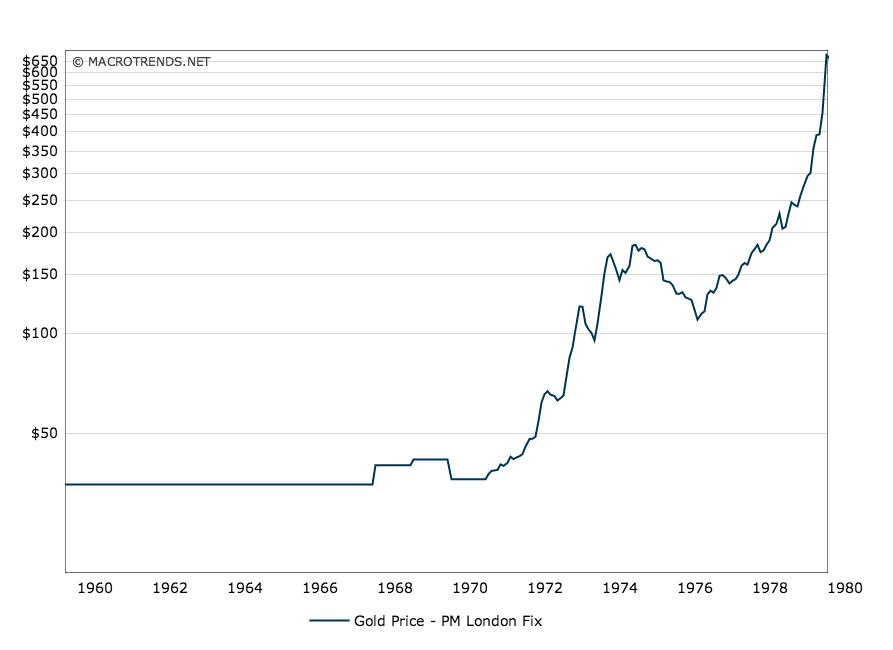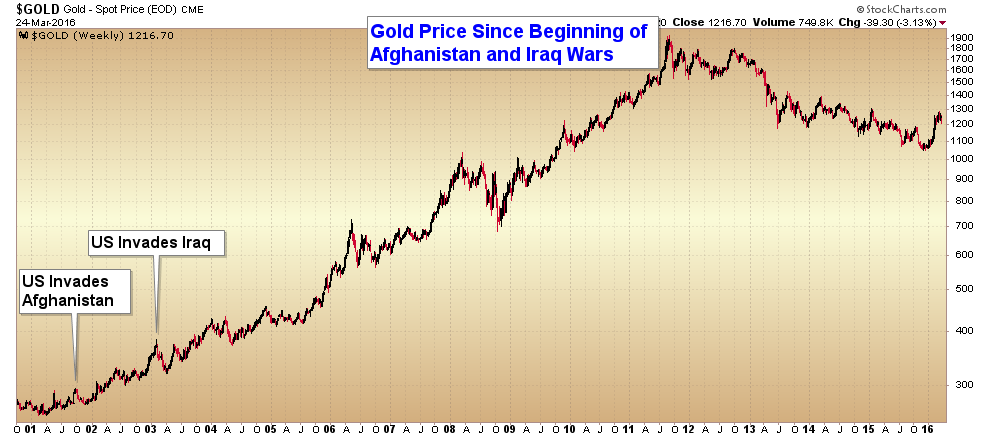War And Gold (Part II)

 In Part I of this series, we discussed the properties of gold that make it ideal as a storage of wealth. We looked at how governments try to tax citizens without their knowledge, through the process of printing money, called inflation. It is through inflation that governments can spend beyond their means, especially for things like extended overseas war.
In Part I of this series, we discussed the properties of gold that make it ideal as a storage of wealth. We looked at how governments try to tax citizens without their knowledge, through the process of printing money, called inflation. It is through inflation that governments can spend beyond their means, especially for things like extended overseas war.
We will now look at a few examples throughout history to show how gold either stands in the way of this overspending, or rises in price as a warning signal for those who know how to listen.
Gold As The Enforcer Of Fiscal Discipline
Gold stands in the way of reckless government military spending because a currency that is exchangeable for gold cannot be printed out of thin air.
Books have been written about this historical subject, and my attempt is not to repeat such here. A few brief examples will suffice.
A. One of the primary causes of the decline of the Roman Empire was military overexpansion. During the later stages of the 3rd-century campaign, the leaders of Rome attempted to pay for wars by fabricating more money out of existing coinage. By diluting Rome's gold and silver coins and replacing them with copper, they could create 5 or 10 coins where they previously had one. To pay for war expenses, by the end of the Empire, the gold/silver content of most Roman coins reached nearly zero.
The Empire subsequently collapsed.
B. After World War I, Germany found itself saddled with tremendous war debt. In an attempt to repay its creditors more quickly than the direct taxation of German gold marks from its citizens would allow, the government began to issue new, unbacked currency. From 1914 to 1924, the value of one ounce of gold went from one mark to over one-trillion marks, representing the number of new marks printed by the government. By the mid-1920's, German marks were worth more as kindling in fireplaces than as currency.


C. Finally, after piling up tremendous debt through engaging in an unwinnable war in Vietnam from the early 1960's through 1975, President Nixon was forced to remove the U.S. dollar from its gold backing at $35 per ounce, which had held since 1933. After abandoning the gold standard in 1971, the price of gold rose over 2,400%, to $850 per ounce, in just nine years, reflecting the devaluation of the U.S. dollar.
Back To The Present
Since the beginning of the war in Afghanistan in 2001 and the war in Iraq in 2003, the price of gold has risen roughly 400%, from $250 per ounce to $1,250.
Just as in other historical periods of unwinnable international war, the gold price over the last 15 years is telling us something, i.e., our government is printing money to pay for what it cannot afford.
In doing so, the government is robbing from those who save in U.S. dollars by debasing the purchasing power of their money. Just as in the example of the Roman Empire coins above, the current chart of gold, as priced in U.S. dollars, is reflecting an increase in currency without the backing of any monetary asset.
This has been tried over and over throughout history, and every, single time it has failed.
It is said that those who fail to learn from history are doomed to repeat it. Will we learn?
As a society, we will probably not act until serious damage is done.
Yet for individuals who can read the warning signs, there is still time to protect themselves.
The Current Perpetual War
The United States and major Western allies are now engaged in what can only be called perpetual war.
For the first time in US history, the pretext has been given for us to be engaged in preemptive overseas wars without end.
I have seen with my own eyes the unwinnable nature of the wars in Iraq and Afghanistan. Indeed, from my first deployment in 2006 through my second in 2009, I noticed an increase in attacks on bases, increased suicide bombers, loss of control over vast regions of the countries, and a decrease in stability in Kabul and Bagdad. This happened despite the successes of daily kills or captures of senior Taliban or Al-Qaida leaders through ground battles, predator drone strikes, or larger bombing campaigns. These are truly wars without a definable end.
Perpetual war is a concept not many of us can fully comprehend. But, by all measures, it appears that the rationalization has been given for us to be engaged in continuous war for the rest of our lives and beyond.
Summary
Gold stands in the way of perpetual war.
When a currency is backed by gold, it halts the excessive spending by the Treasury for unsustainable overseas war.
When a currency is not backed by gold, gold rises in price to signal a warning sign that the currency is being devalued. Such is what we have observed in the price of gold over the last 15 years.
Perpetual war is here. While the government can dilute your savings of U.S. dollars to pay for it, it cannot dilute gold. The importance of this connection is critical for individuals and institutions to understand now, and for the duration of the US policy of continuous international war.





















